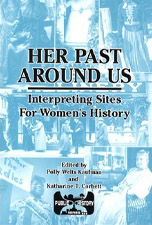Book Review
Her Past Around Us: Interpreting Sites for Women's History
Edited by Polly Welts Kaufman and Katharine T. Corbett. Malabar, FL: Krieger Publishing Company, 2003; viii + 261 pp., photographs, notes, suggested readings, index; cloth $33.50.
 |
Few sources could weave such wide-ranging yet closely related women's issues into one text as does this collection of 11 essays recounting the stories of Native American women, colonial settlers, pioneer mothers, domestic immigrants, and wives of presidents. Their stories—in their homes, in their gardens, and in cemeteries—are skillfully recounted in each essay. Readers are led to the realization that without the stories of women's lives, American history has been one-dimensional, clouded by half-truths, and shrouded to exclude most things feminine.
The strength of this book lies in its impressive and thought-provoking suggestions for examining hidden stories of race and gender at historic sites. This comprehensive collection explores diverse and compelling subject matter that is sometimes controversial. As a history text or reference, these essays look at individuals and groups of women who have participated in creating the past. They offer scholars the opportunity to examine the diversity in women's contributions that encompass family, work, and community life.
Although each chapter is uniquely structured with notes, lists of public art, or extensive lists of suggested readings, it reads as one voice, recounting stories almost lost and urging research into corners yet unexplored. Barbara J. Howe offers suggestions for incorporating women's history into public events; adding multiple perspectives may move celebrations from tradition and symbolism to a reality sometimes hard to acknowledge. Eileen Eagan's chapter on the use of public art offers challenging ideas on how to honor women's lives in ways that reconfigure history. She traces the changing public attitudes toward women's history from the Puritan dissenter, Anne Hutchinson, to the Vietnam Women's Memorial.
These essays suggest alternative ways to view women's lives, the contributions they have made, and their imprint throughout history. Bonnie Hurd Smith tells us that unraveling women's lives can be frustrating. Few women were literate or left written records. This text offers new and creative ways to glimpse and interpret the lives of these women. National Park Service historian Tara Travis discusses how Native American women connect with and engage their culture by weaving canyon landscape designs in their rugs. These rugs, sold in the trading posts, offer more insight into Navajo women's culture than simply their creativity.
Several chapters recommend new methods of research that reach beyond the traditional written records. Pamela K. Sanfilippo, park historian for Ulysses S. Grant National Historic Site, explains how archeological investigation of White Haven, the childhood home of Julia Dent Grant, the wife of General, and later President, Ulysses S. Grant, enhances understanding of the Grant family as well as their enslaved servants. Her multidisciplinary approach of combining archeology, architectural analysis, and oral history provides researchers a more comprehensive basis for understanding their subject.
In Margaret Lynch-Brennan's chapter on Irish domestic servants, we are reminded that most histories have focused on the effects of immigrant men in politics; ignored are the female live-in domestic servants who worked in the homes of presidents and noted individuals such as Elizabeth Cady Stanton. Lynch-Brennan suggests several themes educators might use to direct students to nontraditional areas of study, including the economic and social reasons for immigration, the cultural and material world left behind and the new world encountered, and the advantages offered to both the employers and the young girls entering service.
The chapter on creating women's history trails written by Polly Welts Kaufman introduces readers to the pride and respect for diverse places and peoples that can be fostered by new interpretive content and strategies. Kaufman emphasizes the importance of developing historical context, cultivating community involvement, and identifying representative women along with notable women.(1)
Still other essays encourage the reader to look where one has never looked before. One chapter commemorates the roles of women in major historical events, such as Sarah Fulton's role in organizing the Boston Tea Party. Another discusses reinterpreting historic house museums and women's history in 19th-century cemeteries and gardens. To borrow from interpreter Doug Capra, each story is not simply a tidbit of interesting fact but another bead strung on a thread, each thread a strand in the fabric that binds our national story.(2)
This collection blends sites, ideas, and suggestions, and provokes not only those working to interpret women's history but those seeking to understand a holistic story. This is an important book for those who manage historic sites and a challenge to educators and visitors to demand to hear the stories previously hidden in attics and basements, traditionally ignored and considered minor. Any great nation that survives and thrives must pay respect to the full memory of its past. One finishes the collection knowing that without the entire story, including the unsavory aspects, our history would be forever incomplete, limiting our understanding of the potential for America's future.
Sandy Brue
National Park Service
Notes
1. Polly Welts Kaufman is the author of National Parks and the Woman's Voice: A History (Albuquerque: University of New Mexico Press, 1996).
2. Doug Capra, "Tour Boats and Buses and Trains, Oh My!: Interpretation in the Land of Oz," 2002 Interpretive Sourcebook, Proceedings of the National Interpretive Workshop (Boulder, CO: Interp Press, 2002), 18.
